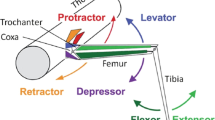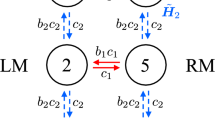Abstract
The general, model-independent features of different networks of six symmetrically coupled nonlinear oscillators are investigated. These networks are considered as possible models for locomotor central pattern generators (CPGs) in insects. Numerical experiments with a specific oscillator network model are briefly described. It is shown that some generic phase-locked oscillation-patterns for various systems of six symmetrically coupled nonlinear oscillators correspond to the common forward-walking gaits adopted by insects. It is also demonstrated that transitions observed in insect gaits can be modelled as standard symmetry-breaking bifurcations occurring in such systems. The present analysis, which leads to a natural classification of hexapodal gaits by symmetry and to natural sequences of gait bifurcations, relates observed gaits to the overall organizational structure of the underlying CPG. The implications of the present results for the development of simplified control systems for hexapodal walking robots are discussed.
Similar content being viewed by others
References
Alexander R McN (1977) Terrestrial locomotion. In: Alexander R McN, Goldspink JM (eds) Mechanics and energetics of animal locomotion. Chapman and Hall, London, pp 168–203
Ashwin P (1990) Symmetric chaos in systems of three and four forced oscillators. Nonlinearity 3:603–617
Bässler U (1983) Neural basis of elementary behavior in stick insects. Springer, Berlin Heidelberg New York
Bässler U (1986) On the definition of central pattern generator and its sensory control. Biol Cybern 54:65–69
Bässler U (1987) Timing and shaping influences on the motor output for walking in stick insects. Biol Cybern 55:397–401
Bay JS, Hemami H (1987) Modeling of a neural pattern generator with coupled nonlinear oscillators. IEEE Trans Biomed Eng 34:297–306
Burrows M (1980) The control of sets of motoneurons by local interneurones in the locust. J Physiol 298:213–233
Chossat P, Golubitsky M (1988) Symmetry-increasing bifurcation of chaotic attractors. Physica D 32:423–436
Collins JJ, Stewart IN (1992) Symmetry-breaking bifurcation: A possible mechanism for 2∶1 frequency-locking in animal locomotion. J Math Biol (in press)
Collins JJ, Stewart IN (1993) Coupled nonlinear oscillators and the symmetries of animal gaits. J Nonlin Sci (in press)
Cohen AH, Holmes PJ, Rand RH (1982) The nature of the coupling between segmental oscillators of the lamprey spinal generator for locomotion: a mathematical model. J Math Biol 13:345–369
Cruse H (1979) A new model describing the coordination patterns of the legs of a walking stick insect. Biol Cybern 32:107–113
Cruse H (1980a) A quantitative model of walking incorporating central and peripheral influences. I. The control of the individual leg. Biol Cybern 37:131–136
Cruse H (1980b) A quantitative model of walking incorporating central and peripheral influences. II. The connections between the different legs. Biol Cybern 37:137–144
Cruse H (1990) What mechanisms coordinate leg movement in walking arthropods? Trends NeuroSci 13:15–21
Dean J (1991) A model of leg coordination in the stick insect, Carausius morosus. II. Description of the kinematic model and simulation of normal step patterns. Biol Cybern 64:403–411
Delcomyn F (1980) Neural basis of rhythmic behavior in animals. Science 210:492–498
Delcomyn F (1985) Factors regulating insect walking. Annu Rev Entomol 30: 239–256
Field MJ, Golubitsky M (1990) Symmetric chaos. Comput Phys (Sep/Oct):470–479
Foth E, Graham D (1983) Influence of loading parallel to the body axis on the walking coordination of an insect: II. Contralateral changes. Biol Cybern 48:149–157
Gambaryan P (1974) How mammals run: anatomical adaptations. Wiley, New York
Getting PA (1988) Comparative analysis of invertebrate central pattern generators. In: Cohen AH, Rossignol S, Grillner S (eds) Neural control of rhythmic movements in vertebrates. Wiley, New York, pp 101–127
Golubitsky M, Stewart IN (1985) Hopf bifurcation in the presence of symmetry. Arch Rational Mech Anal 87:107–165
Golubitsky M, Stewart IN (1986) Hopf bifurcation with dihedral group symmetry: coupled nonlinear oscillators. In: Golubitsky M, Guckenheimer J (eds) Multiparameter bifurcation theory. Contemporary Mathematics, vol 56. Am Math Soc Providence, pp 131–173
Golubitsky M, Stewart IN, Schaeffer DG (1988) Singularities and groups in bifurcation theory, vol II. Springer, Berlin Heidelberg New York
Graham D (1972) A behavioural analysis of the temporal organization of walking movements in the 1st intar and adult stick insect Carausius morosus. J Comp Physiol 81:23–52
Graham D (1977) Simulation of a model for the coordination of leg movement in free walking insects. Biol Cybern 26:187–198
Graham D (1978a) Unusual step patterns in the free walking grasshopper Neoconocephalus robustus. I. General features of the step patterns. J Exp Biol 73:147–157
Graham D (1978b) Unusual step patterns in the free walking grasshopper Neoconocephalus robustus. II. A critical test of the leg interactions underlying different models of hexapod co-ordination. J Exp Biol 73:159–172
Graham D (1985) Pattern and control of walking in insects. Adv Insect Physiol 18:31–140
Gray J (1968) Animal locomotion. Weidenfeld and Nicolson, London
Grillner S (1975) Locomotion in vertebrates: central mechanisms and reflex interaction. Physiol Rev 55:247–304
Hoppensteadt FC (1986) An introduction to the mathematics of neurons. Cambridge University Press, Cambridge
Hoyle G (1976) Arthropod walking. In: Herman RM, Grillner S, Stein PSG, Stuart DG (eds) Neural control of locomotion. Plenum Press, New York, pp 137–179
Hughes GM (1952) The coordination of insect movements. I. The walking movements of insects. J Exp Biol 29:267–284
Kennedy D, Evoy WH, Hanawalt JT (1966) Release of coordinated behavior in crayfish by single central neurons. Science 154:917–919
King GP, Stewart IN (1991a) Symmetric chaos. In: Ames WF, Rogers CF (eds) Nonlinear equations in the applied sciences. Academic Press, Boston, pp 257–315
King GP, Stewart IN (1991b) Phase space reconstruction for symmetric dynamical systems. Preprint 64/1991, Mathematics Institute, University of Warwick
Kleinfeld D, Sompolinsky H (1988) Associative neural network model for the generation of temporal patterns: Theory and application to central pattern generators. Biophys J 54:1039–1051
Kopell N (1988) Toward a theory of modelling central pattern generators. In: Cohen AH, Rossignol S, Grillner S (eds) Neural control of rhythmic movements in vertebrates. Wiley, New York, pp 369–413
Kupfermann I, Weiss KR (1978) The command neuron concept. Behav Brain Sci 1:3–39
Macmillan DL, Kien J (1983) Intra- and intersegmental pathways active during walking in the locust. Proc R Soc London Ser B 218:287–308
Mirollo RE, Strogatz SH (1990) Synchronization of pulse-coupled biological oscillators. SIAM J Appl Math 50:1645–1662
Pearson KG (1972) Central programming and reflex control of walking in the cockroach. J Exp Biol 56:173–193
Pearson KG, Franklin R (1984) Characteristics of leg movements and patterns of coordination in locusts walking on rough terrain. Int J Robotics Res 3:101–112
Pearson KG, Iles JF (1970) Discharge patterns of coxal levator and depressor motoneurones of the cockroach, Periplaneta americana. J Exp Biol 52:139–165
Pearson KG, Iles JF (1973) Nervous mechanisms underlying intersegmental coordination of leg movements during walking in the cockroach. J Exp Biol 58:725–744
Pearson KG, Robertson RM (1981) Interneurons coactivating hindleg flexor and extensor motoneurons in the cockroach leg. J Comp Physiol 144:391–400
Raibert MH, Sutherland IE (1983) Machines that walk. Sci Am 248:44–53
Rand R, Cohen AH, Holmes PJ (1988) Systems of coupled oscillators as models of central pattern generators. In: Cohen AH, Rossignol S, Grillner S (eds) Neural control of rhythmic movements in vertebrates. Wiley, New York, pp 333–367
Schöner G, Yiang WY, Kelso JAS (1990) A synergetic theory of quadrupedal gaits and gait transitions. J Theor Biol 142:359–391
Selverston AI (1980) Are central pattern generators understandable? Behav Brain Sci 3:535–571
Shik ML, Orlovsky GN (1976) Neurophysiology of locomotor automatism. Physiol Rev 56:465–501
Song S-M, Waldron KJ (1989) Machines that walk: the adaptive suspension vehicle. MIT Press, Cambridge
Sutherland IE, Ullner MK (1984) Footprints in the asphalt. Int J Robot Res 3:29–36
Wendler G (1968) Ein Analogmodell der Beinbewegungen eines laufenden Insekts. In: Marko H, Färber G (eds) Kybernetik 1968. Oldenbourg, München, pp 68–74
Wendler G (1978) Erzeugung und Kontrolle koordinierter Bewegungen bei Tieren — Beispiele an Insekten. In: Hauske G, Butenandt E (eds) Kybernetik 1977. Oldenbourg, München, pp 11–34
Williams TL, Sigvardt KA, Kopell N, Ermentrout GB, Remler MP (1990) Forcing of coupled nonlinear oscillators: studies of intersegmental coordination in the lamprey locomotor central pattern generator. J Neurophysiol 64:862–871
Wilson DM (1966) Insect walking. Annu Rev Entomol 11:103–122
Wilson DM (1968) An approach to the problem of control of rhythmic behaviour. In: Wiersma CAG (ed) Invertebrate nervous systems. University of Chicago Press, Chicago, pp 219–229
Yee HC, Sweby PK, Griffiths DF (1991) Dynamical approach study of spurious steady-state numerical solutions of nonlinear differential equations. I. The dynamics of time discretization and its implications for algorithm development in computational fluid dynamics. J Computat Phys 97:249–310
Yuasa H, Ito M (1990) Coordination of many oscillators and generation of locomotory patterns. Biol Cybern 63:177–184
Author information
Authors and Affiliations
Rights and permissions
About this article
Cite this article
Collins, J.J., Stewart, I. Hexapodal gaits and coupled nonlinear oscillator models. Biol. Cybern. 68, 287–298 (1993). https://doi.org/10.1007/BF00201854
Received:
Accepted:
Issue Date:
DOI: https://doi.org/10.1007/BF00201854




